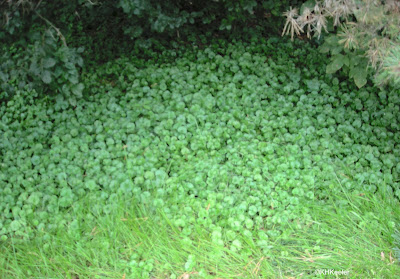 |
| Ground ivy, creeping Charlie, Glechoma hederacea, |
I first noticed it as a weed in my lawn in Lincoln, Nebraska. I weeded it out, only to find more. It was rising on my "Plants I Don't Like" list, until I identified it as a traditional medicinal herb from Europe. What jumped it to "Plant I Like" was finding that it was, under the name alehoof, an important ingredient in brewing in medieval Europe, so long ago that Europeans were not using hops in beer. Hops reportedly came from Egypt, reaching Germany in 800s, the Netherlands and Belgium in the 13th century and England in the 15th. Alehoof/ground ivy was a part of a mixture called gruit, used for flavoring, to clarify the beer, and probably because "we've always done it that way." I never made beer with it, but I very much enjoyed the idea that this weed in my yard was a useful plant 1,500 or more years ago.
Once you feel a little positive about it, you notice its pretty purple flowers and slightly-minty smelling leaves. It is in the mint family (Lamiaceae or Labiatae). It not just smells minty and has typical mint-like flowers, but it has the characteristic square stems (only one other common plant family has square stems, the verbenas, Verbenaceae, and their leaves don't have a scent.) It is unusual as mint because it creeps across the ground on fairly long horizontal stems. Ground ivy, the common name government websites use, reflects that creeping habit, but that name is misleading, since it is not related to English ivy or poison ivy, or any other famous ivy.
 |
| ground ivy, spreading |
Ground ivy was probably brought to North America as a medicinal plant. The traditional European herbals use it for upper respiratory problems, stomach ailments, against tintinitis and eye problems...and more. Current herb books and websites use it for throat and chest problems. The scientific sites find little support for any of the medical uses. However, though publications on PubMed show compounds in ground ivy have biological activity; biological activity means it is an active ingredient when used on living things, but does not necessarily mean it is good for living things. Web M.D. says early research reported a lotion including ground ivy was soothing to sunburn. The blog Eattheweeds refers to studies that say it inhibited some viruses and stimulated blood platelets. After all these centuries of people using ground ivy medicinally, it looks to me like the scientific community hasn't found any strong medicinal properties.
 |
| Lots of ground ivy under a tree at the edge of a lawn |
Ground ivy is edible. People have been eating it as a green since before there were records. It is reported as toxic to horses, though other livestock seem to tolerate or avoid it. Horses have to eat large amounts of it, which they generally will not do voluntarily. This does suggest that humans, also, should be wary of eating it in large quantities, and unhealthy or pregnant individuals would be wise to avoid it. But you could put a sprig or two in a salad for color or zing.
 |
| lawn with too much ground ivy |
Bauman, J. 2016. Mother Earth Living link / (Accessed 5/5/21)
British Hop Association. History of Hops. link (Accessed 5/4/21)
Grant, A. Eating Ground Ivy: Is Creeping Charlie Edible? Gardeningknowhow.com link (Accessed 5/5/21)
Greene, D. Ground Ivy. eatheweeds blog. link (Accessed 5/5/21)
Ground Ivy. www.rxlist.com link Good source of safety considerations, in short: don't eat large quantities. (Accessed 5/5/21)
Ground ivy. WebMD https://www.webmd.com/vitamins/ai/ingredientmono-26/ground-ivy (Accessed 5/5/21)
Ground Ivy Poisoning in Horses. wagwalking.com link (Accessed 5/5/21)
Hops en.Wikipedia link (Accessed 5/5/21)
Plants for a Future. Glecoma hederacea link (Accessed 5/6/21)
Kathy Keeler, A Wandering Botanist
More at awanderingbotanist.com
Join me on Facebook: https://www.facebook.com/AWanderingBotanist


Interesting! It's a weed over here in the East Coast. I noticed bees visiting it, but had to get rid of it since it was starting to spread onto neighbor's lawn.
ReplyDeleteHow to get rid of it.
ReplyDelete